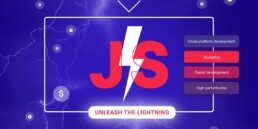As consumers increasingly use mobile devices for their day-to-day web surfing and e-commerce needs, more attention has to be put on the mobile UX and UI side of things. Experts around the web seem to repeat the same mantra in recent years: users like their mobile phones. Statistics only confirm that – more than 50% of today’s web traffic comes from mobile devices. Ensuring top-notch user experience on phones and tablets is critical for today’s businesses.
Back in the day, designing a “mobile-friendly” or “mobile responsive” website did the trick, yet these trends no longer cut the mustard in 2020. Creating a great mobile experience takes an extra mile. Designers are going out of their ways to conceive newer, sleeker, sexier and more engaging interfaces to stand out from the crowd. Specific UX improvements are pivotal to boosting conversion rates and driving commercial success.
In this article, we take a quick look at the latest trends in designing bleeding-edge, effective user experience on mobile devices.
1. Neuomorphism
Neuomorphism may not be a commonplace trend just yet, but you’d better keep your tabs on it. The concept directly descends from skeuomorphism, i.e. the design philosophy that introduced UI elements resembling real objects to help people understand their function or encourage intuitive interaction.
 Popularized by Apple, skeuomorphism quickly became the standard in mobile design. Here: iBooks with purchased books on display.
Popularized by Apple, skeuomorphism quickly became the standard in mobile design. Here: iBooks with purchased books on display.
 Dribbble user alexplyuto inadvertently launched the neuomorphic revolution with a simple design that went viral (above).
Dribbble user alexplyuto inadvertently launched the neuomorphic revolution with a simple design that went viral (above).
Neuomorphism is considered the modern reincarnation of skeuomorphism. It introduces an entirely new quality. Through the smart use of highlights, shadows and glows, it makes certain elements stand out. Neumorphism is quickly making rounds in the design community and we’re expecting it to become a huge design trend in 2020.
2. Foldable Phone Support
Like it or not, foldable phones are coming in 2020. This new design trend in mobile devices, very likely born of vanity more than practical reasons, encourages completely new ways to utilize folding screens. But at the same time, it also poses a serious challenge for the designers wanting to make the most of the device. Dynamic resizing, multiple windows and gestures, ensuring ease of use – ideally one-handed – will be a must.
3. Animation
Originally used sparingly due to performance issues on mobile devices, animation of UI elements is slowly gaining traction, and will certainly be among the leading trends in 2020. When properly executed, animation helps to increase engagement and continuity. It can be used to introduce interactivity as animated elements encourage fiddling and swiping.
Animation provides feedback. It is a great way to show the effect of users’ actions visually. It gives the user a sense of agency, improving the perceived level of control over the user interface.
Animation example. Source: Home page interactions.
4. Gestures, gestures everywhere
Gestures are the new buttons. We’ve seen it coming for years: as the screens in phones are becoming bigger and bigger, and bezels around them are shrinking, eliminating navigation buttons was only a natural consequence. We’ve seen various manufacturers increasingly follow this trend in recent years, and not only in mobile phones. Bigger devices like the iPad and the iPad Air – which could easily accommodate a physical button – can now also be navigated using gestures.
Likewise, Android’s signature three-button navigation is being phased out – slowly but steadily, Google is replacing it with a new gesture-based interface. The transition will take time, but a slew of completely new design challenges is looming. All new and existing apps will have to find a way to accommodate gestures without conflicting with existing navigation mechanisms in apps.
In particular, “swipe from the edge” gestures in Android apps should be reviewed and possibly redesigned to avoid interference with OS-wide gestures.
 Android’s new gesture navigation replaces the good old button trio.
Android’s new gesture navigation replaces the good old button trio.
5. More subtle gradients
Gradients were already all the rage in 2019, but the trend is expected to continue into 2020. Subtle gradient uses such as delicate shades of blue to light blue, light to dark grey, will proliferate. Even in simple, cartoonish graphics in the UI, gradients enhance designs by introducing depth and dimension into mobile designs.
Unlike the old-style monotone or grayscale colors, mobile app designers can use gradients to produce a warm effect and promote positivity to the users.
6. Passwordless design
With an increasing number of biometric sensors installed in mobile phones, apps will slowly have to embrace new methods for user identification and login. This includes facial or fingerprint authentication instead of the clumsy password entering processes on websites and in apps. When biometrics are not an option, mobile designs should embrace dedicated sign-in links (Medium), and one-time temporary passwords like the ones known from eBay.
Passwords are becoming a thing of the past, and are increasingly incompatible with the modern, sleek and fast UX experience. With so many passwords and rules for their creation (of course you don’t use the same password twice, do you?) it is becoming unwieldy and incredibly difficult to conveniently access websites and log into accounts.
Biometrics (fingerprints or facial recognition) and one-time passwords bring the coveted convenience.
Users simply hate passwords, and future-minded UX designers should keep that in mind when designing interfaces. We believe it’s already happening and expect to see more examples of proper passwordless designs in 2020.
6. Truly cross-device design
With a steady rise in popularity of smart devices such as smart speakers and wearables, it is becoming necessary to think beyond web and mobile-responsive apps or sites. Users own and use several devices, and they expect to be able to switch between them seamlessly. UI/UX design trends will need to include the user journey instead of just thinking about the devices. With dynamic and adaptable mobile app UI designs, it will become easier for users to perform their tasks on any of their smart devices.
Parting words
While the aforementioned trends may, at a glance, have little in common, the overarching goal is clear: to make the user experience better, more intuitive and simple, allowing people to do more with less, further bridging the gap between the user and the mobile device.
There is no way UX designers can rest on their laurels and consider their work done. Whether it’s an app or a website, it’s always work in progress. Cutting-edge user experience requires constant iteration and keeping track of new developments and trends in design.
If you find this article valuable, you can share it on social media →
Read more about the VOD & OTT Industry!
October 27, 2023
The power of video analytics: optimize video content with data
Learn how video analytics measures ROI, improves user experience and enhances content strategy!
June 29, 2023
LightningJS takes the development world by storm, but why?
The pursuit of discovering new, powerful tools lead to the rise of Lightning JS. What are the benefits of this popular TV app framework?
June 15, 2023
Signs of outdated frontend part 2: More red flags
Old practices may get in the way of the success of your solution. Lear the top signs of outdated frontend in our second take on this topic.
Are you looking for a partner to build a Video Solution?
Leave your email and a short description about your project. We would gladly discuss different cooperation possibilities!








